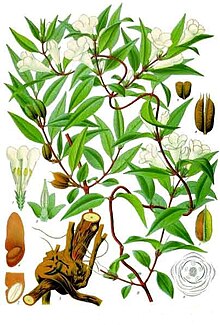Gelsemium
| Gelsemium | |
|---|---|

| |
| Gelsemium sempervirens[1] | |
| Scientific classification | |
| Kingdom: | Plantae |
| Clade: | Tracheophytes |
| Clade: | Angiosperms |
| Clade: | Eudicots |
| Clade: | Asterids |
| Order: | Gentianales |
| Family: | Gelsemiaceae |
| Genus: | Gelsemium Juss. |
| Synonyms[2] | |
| |
Gelsemium is an Asian and North American genus of flowering plants belonging to family Gelsemiaceae. The genus contains three species of shrubs to straggling or twining climbers. Two species are native to North America, and one to China and Southeast Asia.[2]
Carl Linnaeus first classified G. sempervirens as Bignonia sempervirens in 1753; Antoine Laurent de Jussieu created a new genus for this species in 1789. Gelsemium is a Latinized form of the Italian word for jasmine, gelsomino. G. elegans has the common name "heartbreak grass".[3]
Properties
All three species of this genus are poisonous.
Active components
The active components of gelsemium are the
Gelsemium has been shown to contain methoxyindoles.[5][6]
Medicinal uses
As late as 1906, a drug called Gelsemium, made from the rhizome and rootlets of Gelsemium sempervirens, was used in the treatment of facial and other neuralgias. It also proved valuable in some cases of malarial fever, and was occasionally used as a cardiac depressant and in spasmodic affections, but was inferior for this purpose to other remedies.[7]
Species
| Species | Common names | Areal | Characteristics | Image |
|---|---|---|---|---|
| Gelsemium elegans | Heartbreak grass | Native to India, Indonesia, Laos, Malaysia, northern Myanmar, Taiwan, northern Thailand, Vietnam, and the Chinese provinces of Fujian, Guangdong, Guangxi, Guizhou, Hainan, Hunan, Jiangxi, Yunnan, and Zhejiang | Twining climber, found in scrubby forests and thickets from 200–2000 meters elevation | 
|
| Gelsemium rankinii | Rankin's jessamine, swamp jessamine, Rankin's trumpetflower | Native to southeastern United States | 
| |
| Gelsemium sempervirens | Yellow jessamine, Carolina jessamine, evening trumpetflower | Native to southeastern and south-central United States from Virginia to Texas and south through Mexico to Central America | It is commonly grown as a garden flower worldwide | 
|
Alleged poisoning victims
- On 23 December 2011, Long Liyuan, a Chinese billionaire, died after eating cat stew that was allegedly poisoned with Gelsemium elegans.[8][9]
- On 10 November 2012, Royal Botanical Gardens, Kew, the Police and coroner concluded that he died of natural causes.[12]
Symptoms of poisoning
The poison affects the vision and respiration.[13] Symptoms can appear almost immediately.[14]
Arthur Conan Doyle's experiment
A rare case of Gelsemium addiction
In his classic early 20th century work on psychotropic drugs Phantastica, German pharmacologist Louis Lewin recounts the seemingly unique case of a person who became addicted (in a manner far more often associated with opiates) to a Gelsemium preparation:
during a severe attack of
mental confusion.[18]
References
- ^ 1897 illustration from Franz Eugen Köhler, Köhler's Medizinal-Pflanzen
- ^ . includes description, drawings, distribution map, etc.
- ^ Lewis, Leo (2012-01-04). "A purrfect murder? Tycoon killed by poisoned cat stew". The Times. Retrieved 2012-01-04.
...the fatal dose of Gelsemium elegans, a highly poisonous plant known as 'heartbreak grass'
- ^ Drugs, Gelsemium
- .
- .
- New International Encyclopedia(1st ed.). New York: Dodd, Mead.
- ^ "China tycoon "ate poisoned cat-meat stew"". BBC News. 4 January 2012.
- ^ "Police: Poisoned cat meat killed China tycoon". Time. 3 January 2012. Archived from the original on 9 February 2012.
[...] is suspected of poisoning the hotpot with the herb Gelsemium elegans, according to a statement on the microblog of the investigating police.
- ^ "Russian whistleblower had traces of rare poison in stomach, plant expert says". The Guardian. London, UK.
- ^ "Alexander Perepilichny: Rare Chinese poison found in stomach of Russian whistleblower". ABC News. 20 May 2015. Retrieved 2 June 2015.
- ^ "[Alexander Perepilichnyy: The questions raised by Russian whistleblower inquest]". BBC News.
- ^ "Gelsemium". Botanical.com. Retrieved 2 June 2015.
- ^ Devlin, Hannah (18 May 2015). "Gelsemium: the plant that can cause convulsions, paralysis and asphyxia". The Guardian. Retrieved 2 June 2015.
- ^ Doyle, Arthur Conan (1986). Gibson, J.M.; Green, R.L. (eds.). Letters to the Press. University of Iowa Press.
- ^ Doyle, Arthur Conan (20 September 1879). "Arthur Conan Doyle takes it to the limit". British Medical Journal. BMJ Publishing Group Ltd. Retrieved 2 February 2014.
- ^ Doyle, Arthur Conan (20 September 1879). "Letters, Notes, and Answers to Correspondents". British Medical Journal. BMJ Publishing Group Ltd. Retrieved 2 February 2014.
- ^ Lewin L. Phantastica. Die betäubenden und erregenden Genussmittel. Für Ärzte und Nichtärzte (trans. Phantastica: Narcotic and Stimulating Drugs. For Doctors and Non-doctors) Berlin: Verlag von Georg Stilke, 1924.
Further reading
- Chisholm, Hugh, ed. (1911). . Encyclopædia Britannica. Vol. 11 (11th ed.). Cambridge University Press. p. 559. This contains a detailed description of the then-common usage and dosage of the drug.
